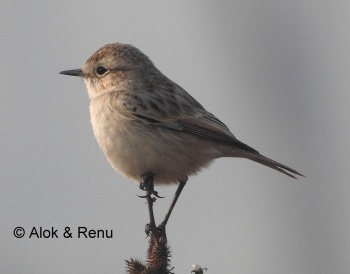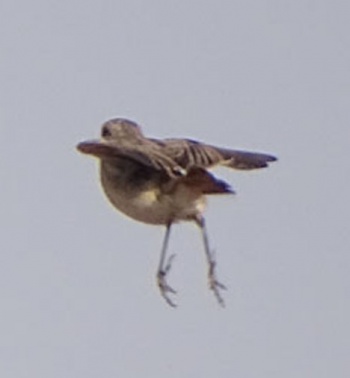Aloktewari (talk | contribs) (Clear image of male / Gallery created to preserve previous image ( not in the database) |
Aloktewari (talk | contribs) (Legend image 1) |
||
| Line 1: | Line 1: | ||
| − | [[Image:white-browed_bushchat_alok.JPG|thumb|550px|right|Winter male<br /> Photo by {{user|aloktewari| | + | [[Image:white-browed_bushchat_alok.JPG|thumb|550px|right|Winter male<br /> Photo by {{user|aloktewari|Alok Tewari}}<br />Gurgaon Rural, Haryana, [[India]], December-2017 <!--EDITORS: this image does not appear in the Gallery-->]] |
'''Alternative name: Stoliczka's Bushchat''' | '''Alternative name: Stoliczka's Bushchat''' | ||
;[[:Category:Saxicola|Saxicola]] macrorhynchus | ;[[:Category:Saxicola|Saxicola]] macrorhynchus | ||
Revision as of 09:32, 20 February 2018
Alternative name: Stoliczka's Bushchat
- Saxicola macrorhynchus
Identification
17 cm (6¾ in)
Males in summer plumage blackish above and white below with a buff-tinged breast; also white supercilium, scapulars, primary coverts, upper tail coverts, and inner webs of the tail feathers.
Females, juveniles and winter males buffy-brown above, and pale buff where summer males are white (except inner webs of the tail feathers, white in males at all times).
Similar Species
Very similar to Whinchat but slightly larger, more attenuated and longer-tailed.
Distribution
Winters in northwestern India and eastern Pakistan in Indus valley lowlands. Breeding grounds not known, and few recent records of summer males. Formerly more widespread, thought to be breeding possibly in northern Pakistan and eastern Afghanistan, but no nest has ever been found[3].
Taxonomy
This is a monotypic species[1]. Most closely related to Whinchat[3].
Habitat
Dry grassland and shrubby vegetation, dry semi desert areas. Threatened because of agricultural intensification and encroachment.
Behaviour
Similar to Whinchat.
Diet
Their diet consists mostly of insects, particularly beetles and ants, also flying insects.
Gallery
Click images to see larger version
Winter Male
By Jugal Tiwari
Kutch, Gujarat, India, December, 2008
References
- Clements, J. F., T. S. Schulenberg, M. J. Iliff, D. Roberson, T. A. Fredericks, B. L. Sullivan, and C. L. Wood. 2017. The eBird/Clements checklist of birds of the world: v2017, with updates to August 2017. Downloaded from http://www.birds.cornell.edu/clementschecklist/download/
- Del Hoyo, J, A Elliot, and D Christie, eds. 2005. Handbook of the Birds of the World. Volume 10: Cuckoo-Shrikes to Thrushes. Barcelona: Lynx Edicions. ISBN 978-8487334726
- Urquhart, E., & Bowley, A. (2002). Stonechats A Guide to the Genus Saxicola. Helm.
- Handbook of the Birds of the World Alive (retrieved Oct 2017)
Recommended Citation
- BirdForum Opus contributors. (2024) White-browed Bushchat. In: BirdForum, the forum for wild birds and birding. Retrieved 24 April 2024 from https://www.birdforum.net/opus/White-browed_Bushchat
External Links







